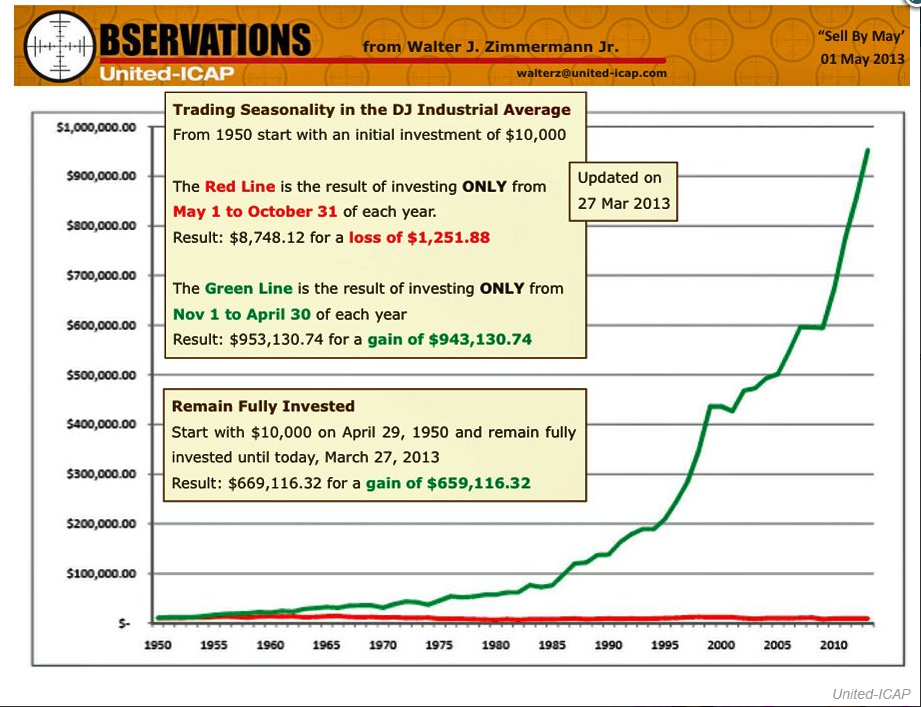It’s fun to see how a serious field like investing comes with these semi-astrological predictions…
There is an old saying telling investors to sell in May and come back in October. This is the result if you follow the “Sell in May and Go Away” along with “Buy back on Saint Crispin’s Day” which is in late October.
Some people can say it’s as good as fortune tellers’ stories but there is one thing that tickles me; there is some pretty strong data to support it! The most interesting graph I have found was produced by Walter J. Zimmermann Jr. from United-ICAP. It clearly shows that an investor that bought only from May 1st to October 31st (so doing the opposite of the old saying) loses money over the past 62 years of stock market history!
On the opposite hand, if you only buy from November 1st and sell on April 30th, the investor is making a fortune from 1950 to today. Somewhere in between, someone who’s fully invested no matter what is making money but definitely less than if they would follow this twisted rule:
Source: United-ICAP [2] (pdf document)
Well, even if I don’t believe in technical analysis [3] too much, I wonder how I could believe in this. It’s not like I will get rid of my entire portfolio today just to make sure I don’t lose money over the summer.
Losing on Dividend Growth
The deceiving part of those sell in May believers is that dividend payouts have been ignored in this comparison. I understand why as nobody has the time to track dividend payments over a period of 63 years. Nonetheless, I believe that the dividend investor will benefit from keeping his stocks throughout the years to receive its distributions.
There is also tax implications if you are trading in a non-registered account. However, this doesn’t apply to my personal situation for now.
It’s Not Always True
Just for fun, I’ve decided to pull out some non-scientific data post 2008. I looked at the S&P500 from May to October for 2009, 2010, 2011 and 2012 just for fun. Here’s what I found:
2009 +19.62%
2010 -0.29%
2011 -5.76%
2012 +0.63%
After 4 four years, I’ve cumulated a gain of +13% (total return not annualized). If you add a few dividend payments throughout those months, I would have been a clear loser to ignore these 6 months of the year. On the other hand, 2009 makes a huge difference in the calculation. Nonetheless, I’m pretty sure that the payment of dividends compensate for the loss in 2011 over the long run.
Technically, it is true that there is a lot more money to make from November to April but there are still some bucks lying on the floor for the summer months!
I’m Not Selling but I’m Stop Selling!
I won’t be selling any of my stocks over summer time. However, I’ll put a few stop sell instructions on specific stocks to make sure I cash out most of my profits. The best example in how to use this strategy is definitely on Seagate Technology (STX). After STX last quarterly results (last week), the stock jumped by more than 10% in 2 days. I’m currently showing a paper profit of 66% on this trade (not counting dividends!).
It is very tempting for me to close this trade now, and look for something else to buy. But I hate to leave money on the table and since the company continues to be traded with a very low P/E ratio and pays a juicy dividend, I want to keep riding the stock.
The best way for me to do it is to put a stop sell at $39. Since the stock is now trading around $41, this gives me some room to navigate. If the stock drops under $39, I’ll automatically sell the stock and cash in some nice profit. If it keeps going up, I won’t have to worry.
What about you? Are you selling, buying or holding in May?
Google+ [4]